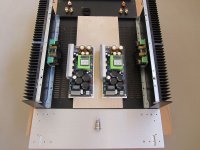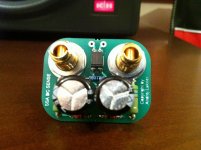Cables with active shielding are then the reason of tickling sound, maybe they needs the battery to be connected.
Hi LC. The shielding is active using wallwart transformer. My worry is active shielding did do some major damage to my CJ350 in the past so i am not so brave to do that
Quan
Hi LC. The shielding is active using wallwart transformer. My worry is active shielding did do some major damage to my CJ350 in the past so i am not so brave to do that.
Quan
OK, understood.
But then shielding is not of any use since producer provided it to be active all the way. Why not to disable the shielding completely then by removing it or shorten it into complete isolation from main conductors inside the cable. Is there any schematic of this active shielding cable somewhere on the net?
That's a sad story and hard learning with those burned output devices, understand your caution.I am a bit reluctant to do that. I used to have Conrad Johnson amp 350 and the active shielding took out the whole output transistors so since then shielding is not used any more with any amps.
Thanks Byrtt. I will take out the bypass caps to see if it is making any difference. I may even try Cap multiplier supply instead to see if the problem goes away.
Quan
 ... you soon can play your favorite speakers/cable. CM shown very good functionality and sound reports at the different VSSA threads, maybe save some time and try that first if you have it at hand. Good soldering.
... you soon can play your favorite speakers/cable. CM shown very good functionality and sound reports at the different VSSA threads, maybe save some time and try that first if you have it at hand. Good soldering.Edit: Post 1 says supply voltage +/-40 V to +/-63 V guess you inside spec.
Last edited:
Hi, Pinnocchio, I'm afraid it is out of topic here.
Just a serial RLC network to compensate the resonnance of the speakers at its resonnance frequency in free air, and a zobel for the upper part of the spectrum. both connected parallel to the speaker coils.
Target is to have a *flat impedance* curve with value equal to the DC resistance of the coil.
An example here: http://www.esperado.fr/images/temp/aeria_full_filterj.gif where Zobel is red, and 'motional compensation' (or resonance) is green. Here, the zobel and the filter's capacitance of the boomer were mixed in a simple 47µF value. And the medium/high frequencies driver has a more sophisticated zobel to be flat up to >40Khz.
Of course, passive filters have to be calculated or modified with this flat charge, but is is much simpler. Keep them with the speakers, even with active filters.
You'll never believe the improvement, and, as said BYRTT will never live any more without. !
maybe a thread to disquass it without getting out of topic?i would be interested for some info.
I decided to give-it up with endless fights and boring argues, but:maybe a thread to disquass it without getting out of topic?i would be interested for some info.
http://www.diyaudio.com/forums/mult...ductance-mpedance-correction-loudspeaker.html
Hi LC- see below -from SR website re active shielding:OK, understood.
But then shielding is not of any use since producer provided it to be active all the way. Why not to disable the shielding completely then by removing it or shorten it into complete isolation from main conductors inside the cable. Is there any schematic of this active shielding cable somewhere on the net?
We then experimented with closed circuits, where the shield carried a DC current, with a buffer circuit between shield and ground and separate conductors carrying the ground signal. This closed circuit design not only improved subjective performance, but also made our cables measureably quieter, thus improving detail with greater frequency extension from top to bottom. Since a closed circuit draws current, we could no longer use batteries, as this would drain a battery in a matter of hours.Precision-Ref-Speaker
TESLA LE Precision Reference Speaker Cables combine two high current Tricon geometries, two high current TESLA LE Acoustic Reference geometries, Zero Capacitance Active Shielding, and Quantum Tunneling, for linear detail, speed, and warmth. As with the TESLA LE Precision Reference Interconnect, this cable has a unique ability to reveal an amazing level of inner detail with harmonic structure, due to it’s twin runs of both Tricon and Acoustic geometries. Compared to TESLA LE Acoustic Reference Speaker Cables, TESLA LE Precision Reference presents music that is faster, with enhanced pin-point imaging, and air that extends beyond the boundaries of your listening room. This is the perfect speaker cable for high end tube systems, as it enables music and soundstaging detail without emphasizing or detracting form your systems mid-range bloom and warmth. In high end solid state systems, TESLA LE Precision Reference Speaker Cable presents low frequency control and speed, a holographic sound stage, and transparent frequency extension that makes other detailed speaker cables sound analytical and thin by comparison. Available in silver spade or gold BFA banana terminations, and IFT Bi-Wire.
Last edited:
I had a look to their web site.Hi LC- see below -from SR website re active shielding:....
"Active Shielding: Zero Capacitance Apex Active Shielding is the ultimate in detail and transparency, with four active geometries for mid-range warmth, liquidity, and three dimensionality of soundstage."
It is affraying.
About speaker's cables, i use to quote a sentence of Peter Walker, asked by a customer about the cables he recommended for his amplifiers:
"I tend to prefer the ones witch conduct electricity."
Just my two cents if you read my lips.
Last edited:
Yeah , i knowI had a look to their web site.
"Active Shielding: Zero Capacitance Apex Active Shielding is the ultimate in detail and transparency, with four active geometries for mid-range warmth, liquidity, and three dimensionality of soundstage."
It is affraying.
About speaker's cables, i use to quote a sentence of Peter Walker, asked by a customer about the cables he recommended for his amplifiers:
"I tend to prefer the ones witch conduct electricity."
Just my two cents if you read my lips.
Hi quan,
I would try to replace the cables, as you confirmed in the same setup the amp worked fine with other speakers. Just use some usual speaker cables as a test. I understand it's frustrating, but if you do not will to use actual cables as built (and understandable why...) then they have no use at all, IMHO.
Cheers!
I would try to replace the cables, as you confirmed in the same setup the amp worked fine with other speakers. Just use some usual speaker cables as a test. I understand it's frustrating, but if you do not will to use actual cables as built (and understandable why...) then they have no use at all, IMHO.
Cheers!
Member Hose4 has mono SMPS and no hum or his whatsoever.
Very funny
The reason for the hum is the unavoidable ground loop when a shared supply stereo amp is fed from a common ground stereo source. It is the circulating ground currents from the PS centre point that get fed into the amp clean input ground and cause the issue. With a SMPS these currents are of such high frequency that even if a ground loop exists, the problem won't be audible as hum.
I realise that each and every case of ground loop hum is individual and dependent upon the particular components - transformer symmetry, cap capacitance and ESR and (probably) amp CMRR. Using dual rectifiers may help - should probably try it.
Can't you imagine star ?Grounds connected together at the PS and subsequently connected again inside the source - what else would you call that but "unavoidable"?
I believe the hum problem is not the one of ground loops, but currents between references points. RFI EMi is an other thing.
Even with two PSU, you'll have such currents (and loop with AC) across them, because parasitic capacitances in the big transfos.
One of the benefit of the SMPS, on my opinion is the parasitic capacitances between ground (or earth) are reduced because trasfo are more efficient, less volumic, so have less surface between primary and secondary coils.
I don't agree with what you said about hum VS EMI RFI with SMPS: The Hypex is not regulated, so the AC ripple is not reduced more than with a linear PSU.
ps: i can't hear any hum in my system. But, yes, it was a fight.
Last edited:
Just the time he had a look at my:What's the status of this DC sense error circuit?
Just got the SMPS 
I went for the regulated supply, because it measures very good.
Next week I'll know how it sounds in my system if it is better than my F5 (Fairchild, CLC PS) on all areas I'll be very happy.
if it is better than my F5 (Fairchild, CLC PS) on all areas I'll be very happy.
I'm pretty sure that bass will be better with the FO + SMPS, but the big challenge will be soundstage if it can match or surpass the F5.
Tried to find the best layout for my case, I think this one it will be, it's easy with a big case
I'll add also a soft start with temperature control, the main reason is that my nice looking switch can't handle the current so it will done by the relais of the soft start.
As speaker protection I'll add something based on the uPC123, simple and works good.
OK, time to drill some holes
I went for the regulated supply, because it measures very good.
Next week I'll know how it sounds in my system
I'm pretty sure that bass will be better with the FO + SMPS, but the big challenge will be soundstage if it can match or surpass the F5.
Tried to find the best layout for my case, I think this one it will be, it's easy with a big case
I'll add also a soft start with temperature control, the main reason is that my nice looking switch can't handle the current so it will done by the relais of the soft start.
As speaker protection I'll add something based on the uPC123, simple and works good.
OK, time to drill some holes
Attachments
Last edited:
Just got the SMPS
Tried to find the best layout for my case, I think this one it will be, it's easy with a big case
Nice & big casing you have. I am still waiting for mine
For power supply layout, it will be good if they place 180 degree from each others and by facing DSP aluminum heatsink to first one can help to reduce EMI.
James
LC wrote on 9 May 2014:
"Also DC sense error circuit to shutdown SMPS1200A400 in a case of DC potential failure on the First One output will be presented.
Stay tuned "
What's the status of this DC sense error circuit?
Regards,
John
Hi John
DC sense PCB-s in production, available from this week on. These will sense DC voltage on output terminals and send a signal to shutdown SMPS1200A400 or any other PSU.
Regards, L.C.
Attachments
- Home
- Vendor's Bazaar
- First One - mosFET amplifier module

